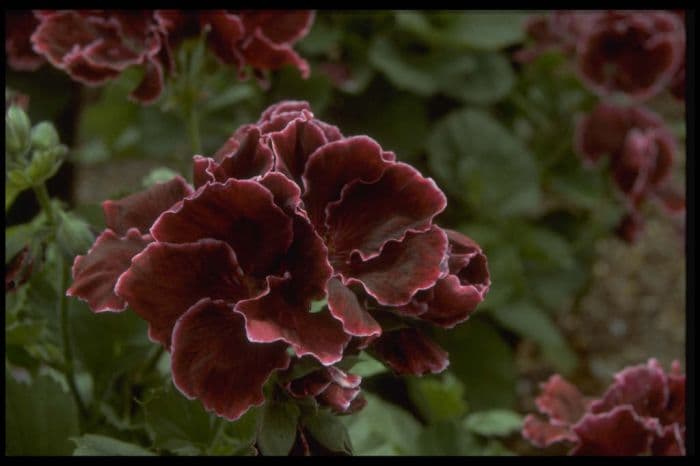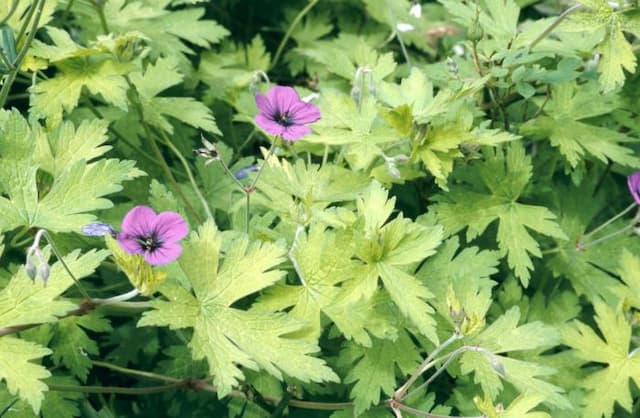Geranium Pelargonium 'Bodey's Picotee' (R)

ABOUT
Pelargonium 'Bodey's Picotee', commonly known as a type of geranium, is a striking ornamental plant. It boasts a unique display of flowers where each petal is elegantly edged with a contrasting color, creating a 'picotee' effect. The blooms are vivid, usually in shades of pink, red, or purple, with these margins often appearing in a crisp white or lighter hue that makes the flowers stand out. The blossoms cluster above the foliage, presenting a showy spectacle when in full bloom. The leaves of 'Bodey's Picotee' geranium are equally attractive, typically green and may have a zonal pattern, with darker markings that add to the plant’s decorative appeal. The foliage often has a soft, velvety texture and may sometimes exude a pleasant fragrance when touched or brushed against, which is a characteristic feature of many geraniums. Overall, this plant is an eye-catching selection for gardeners looking to add a burst of color and elegant contrast to their flower arrangements or garden beds.
About this plant
 Names
NamesSynonyms
Bodey's Picotee Geranium, Picotee Fancy Geranium.
Common names
Pelargonium 'Bodey's Picotee' (R).
 Toxicity
ToxicityTo humans
Geraniums, including Pelargonium 'Bodey's Picotee', are generally considered non-toxic to humans. However, if ingested in large amounts, they might cause mild gastrointestinal upset, such as diarrhea or vomiting. There are no significant toxic effects reported.
To pets
Geraniums, including Pelargonium 'Bodey's Picotee', can be toxic to pets, particularly to dogs and cats. If ingested, they may cause symptoms such as vomiting, diarrhea, depression, anorexia, and dermatitis. In some cases, ingestion can result in more severe reactions like ataxia or hypothermia. It's important to keep these plants out of reach of pets to prevent accidental ingestion.
 Characteristics
CharacteristicsLife cycle
Perennials
Foliage type
Evergreen
Color of leaves
Green
Flower color
Mixed
Height
1-2 feet (30-60 cm)
Spread
1-2 feet (30-60 cm)
Plant type
Herb
Hardiness zones
10
Native area
South Africa
Benefits
 General Benefits
General Benefits- Ornamental Appeal: Pelargoniums, commonly called geraniums, are prized for their beautiful foliage and bright, showy flowers that can enhance the visual appeal of gardens and indoor spaces.
- Low Maintenance: Geraniums are generally easy to care for, requiring minimal attention once established, making them suitable for gardeners of all skill levels.
- Drought Tolerance: These plants are relatively drought-tolerant, needing only occasional watering, which can be beneficial in water-scarce regions or for gardeners seeking water-wise plants.
- Variety of Uses: Geraniums can be used in various landscape designs, including as bedding plants, container plants, borders, or hanging baskets, providing versatility in garden planning.
- Long Blooming Period: Geraniums can bloom from late spring until frost, offering a prolonged period of color and visual interest in the garden.
- Attracts Pollinators: The flowers can attract bees and butterflies, aiding in the pollination of nearby plants and supporting local biodiversity.
- Easy Propagation: Geraniums can be easily propagated from cuttings, allowing gardeners to create new plants from existing ones and share with others.
- Seasonal Adaptability: While they are commonly grown as annuals in colder regions, geraniums can be overwintered indoors or treated as perennials in milder climates, offering flexibility across different zones.
 Medical Properties
Medical PropertiesThis plant is not used for medical purposes.
 Air-purifying Qualities
Air-purifying QualitiesThis plant is not specifically known for air purifying qualities.
 Other Uses
Other Uses- Pressed Flower Art: The vibrant petals of Pelargonium can be pressed and used in creative artwork or to make decorative bookmarks and cards.
- Perfumery: Pelargonium may be used as a source of essential oils for perfumes, offering a floral and slightly green fragrance.
- Aromatherapy: The scent of Pelargonium can be used in aromatherapy for a calming effect, often in scented candles or room diffusers.
- Flavoring Agent: The edible leaves and flowers can impart a unique taste to desserts, jellies, and teas, giving them a subtle rose-like flavor.
- Photography: Due to their striking appearance, Pelargonium flowers can be excellent subjects for botanical photography and garden portfolios.
- Textile Dyeing: The pigments in Pelargonium flowers may be used as a natural dye for fabrics, creating various shades of pink and purple.
- Education: Pelargonium plants are often used in educational settings to teach about plant biology, hybridization, and propagation techniques.
- Culinary Garnish: The attractive flowers can serve as an edible garnish for salads and desserts, adding color and a hint of flavor.
- Water Conservation: Being drought-tolerant, Pelargonium can be used in xeriscaping and water-wise gardens to reduce irrigation needs.
- Crafts and Potpourri: Dried flowers and leaves can be used in crafts, such as homemade potpourri, to add fragrance and decoration to the home.
Interesting Facts
 Feng Shui
Feng ShuiThe plant_name is not used in Feng Shui practice.
 Plant Symbolism
Plant Symbolism- Comfort and Healing: Pelargonium, commonly known as geranium, often symbolizes comfort due to its pleasant scent and is associated with healing because of its use in folk medicine.
- Friendship: The geranium is also a symbol of friendship, making it an appropriate gift for a friend to convey a sense of closeness and trust.
- Positive Emotions: With their bright and colorful appearance, geraniums are often associated with positivity and the upliftment of spirits.
- Good Health: Geraniums are believed to promote good health, as many varieties have been used in traditional remedies for their therapeutic properties.
 Water
WaterFor the geranium 'Bodey's Picotee', water thoroughly whenever the top inch of soil feels dry to the touch. This means checking the moisture level of the soil every few days and watering approximately once every week, but this can vary depending on environmental conditions such as temperature and humidity. Apply water until it begins to run out of the drainage holes in the pot, ensuring that the roots are receiving adequate moisture. On average, this might equal about 16 ounces of water for a medium-sized pot each time you water. Always allow the soil to dry out slightly between waterings to prevent over-watering, which can lead to root rot.
 Light
LightGeraniums like 'Bodey's Picotee' perform best in bright, indirect light or direct morning sunlight. An ideal location would be an east-facing window that receives some direct sun in the morning but is shaded during the intense midday and afternoon heat. Ensure the plant receives at least 4 to 6 hours of filtered sunlight daily for optimal growth and flowering.
 Temperature
TemperatureGeraniums, including 'Bodey's Picotee', prefer temperatures between 65°F and 75°F during the day and should not be exposed to temperatures below 55°F, as they are not frost-tolerant. The ideal nighttime temperature is slightly cooler, around 55°F to 65°F, to promote healthy growth. Keep them away from drafts and cold windowsills to prevent exposure to extreme temperatures.
 Pruning
PruningPrune geraniums like 'Bodey's Picotee' to encourage bushier growth, remove dead or yellowing leaves, and promote more blooms. Pruning should be done in early spring or just before the growing season. Deadhead spent flowers regularly to prolong blooming and cut back the stems by about one-third. This maintenance helps redirect the plant's energy to new growth and flowering.
 Cleaning
CleaningAs needed
 Soil
SoilGeranium 'Bodey's Picotee' thrives in well-draining potting mix with added perlite or coarse sand. The ideal pH for this geranium is between 6.0 and 7.0, slightly acidic to neutral. A mix of peat, compost, and pine bark can also provide the necessary nutrients and structure for healthy growth.
 Repotting
RepottingGeranium 'Bodey's Picotee' should be repotted every 1-2 years, or when it outgrows its current pot. Spring is the best time to repot, giving the plant time to establish in its new container before the growing season.
 Humidity & Misting
Humidity & MistingGeranium 'Bodey's Picotee' prefers moderate humidity but is adaptable to lower levels found in most homes. Aim to maintain humidity between 30% and 50% for optimal growth.
 Suitable locations
Suitable locationsIndoor
Ensure bright light, and let soil dry between waterings.
Outdoor
Plant in full sun, protect from frost, well-draining soil.
Hardiness zone
10-11 USDA
 Life cycle
Life cyclePelargonium 'Bodey's Picotee' (R), commonly known as a geranium, begins its life as a seed, which requires warm soil and proper moisture to germinate. After germination, the seedling emerges and develops true leaves, entering a vegetative growth phase where it focuses on leaf and stem development. The plant then enters a mature stage, producing distinctive foliage and flowers, with petals edged in contrasting colors typical of the 'Picotee' variety. Following pollination, which can occur through self-pollination or with the help of pollinators, the geranium forms seed capsules that, when ripe, can eject seeds up to several meters away. If conditions are unfavorable, the geranium can enter a period of dormancy, particularly in colder climates, where it may die back to the soil line before regrowing again in the spring. The geranium's lifespan can extend for several years, especially when grown in optimal conditions with proper care, including regular deadheading to encourage continuous blooming.
 Propogation
PropogationPropogation time
Spring-Early Summer
The most popular method to propagate the Pelargonium 'Bodey's Picotee', commonly known as Geranium, is through stem cuttings. This is best done in late summer or early fall. To propagate, a healthy stem of about 4 to 6 inches (10 to 15 centimeters) long is selected. The cut is made just below a leaf node, and all but the top few leaves are removed. The cutting is then dipped in rooting hormone powder to encourage root growth and planted in a well-draining soil mix. The pot with the cutting should be kept in a warm, lightly shaded place and maintained moist until roots have developed, which typically takes a few weeks. After the cutting has established a sufficient root system, it can be transplanted to its final location.









